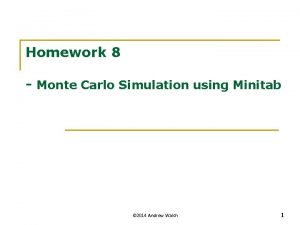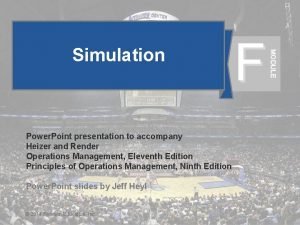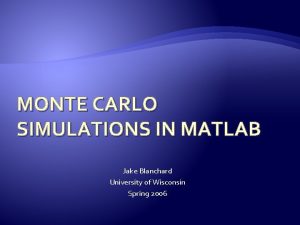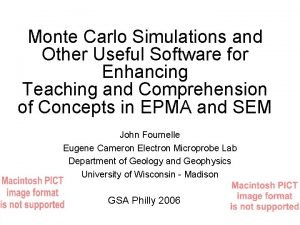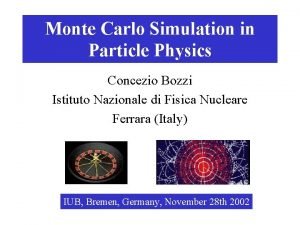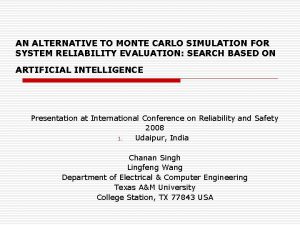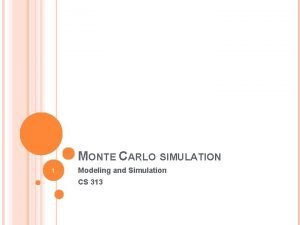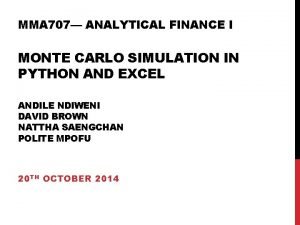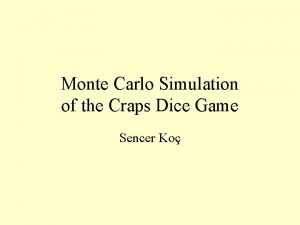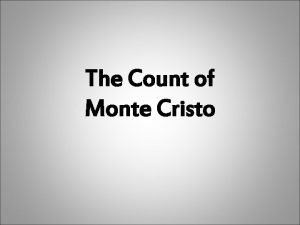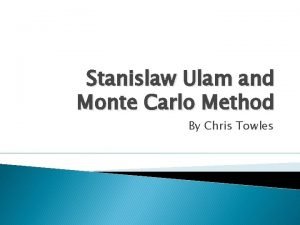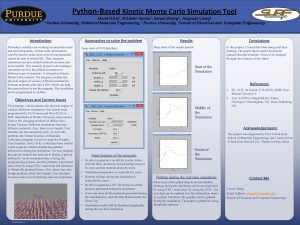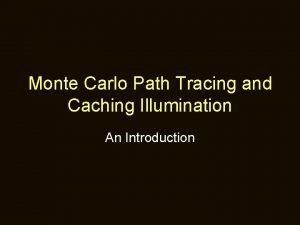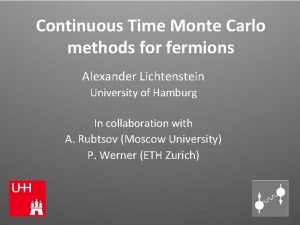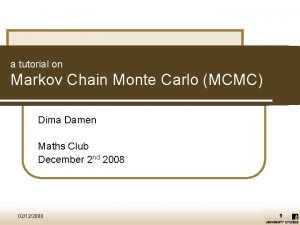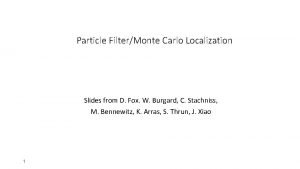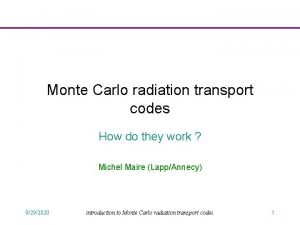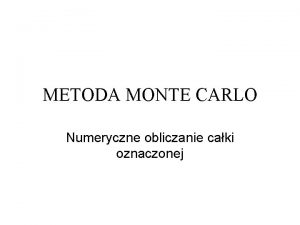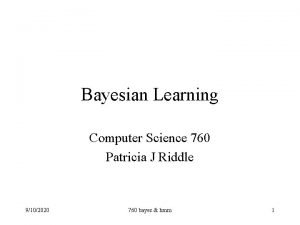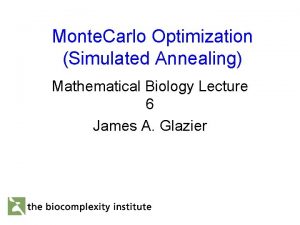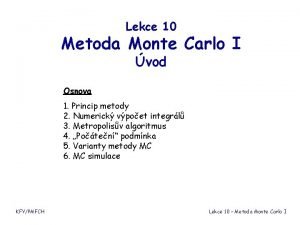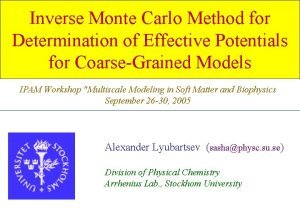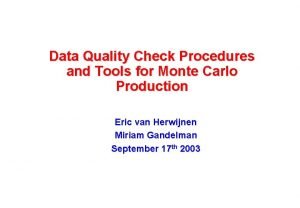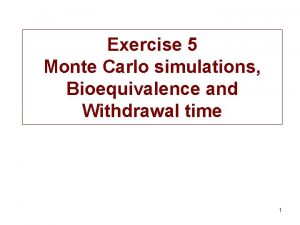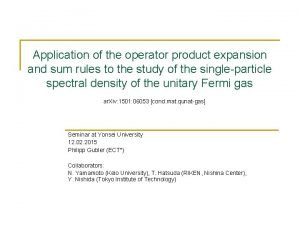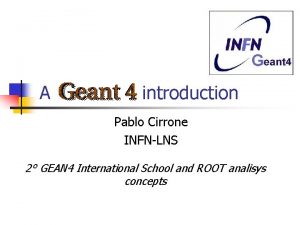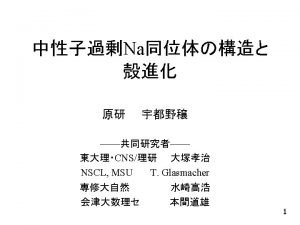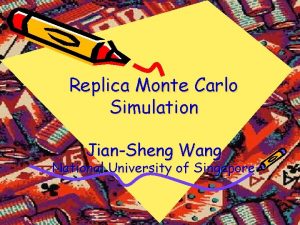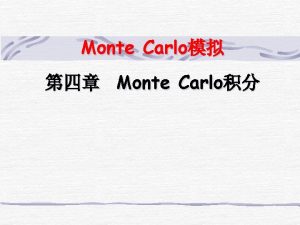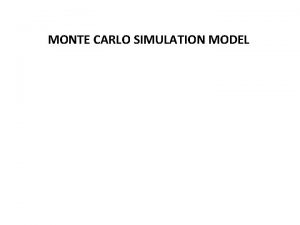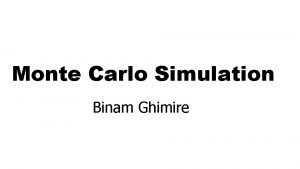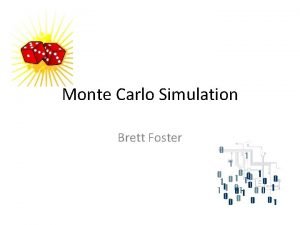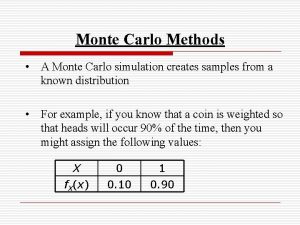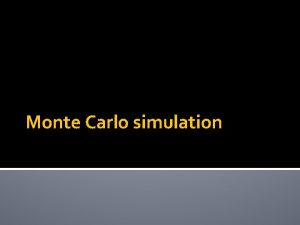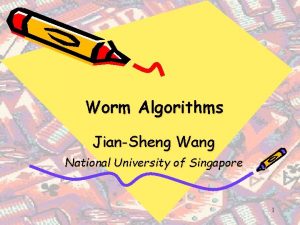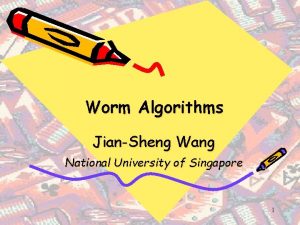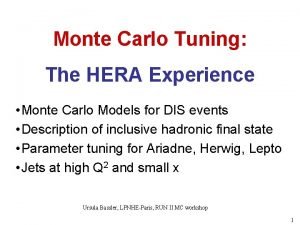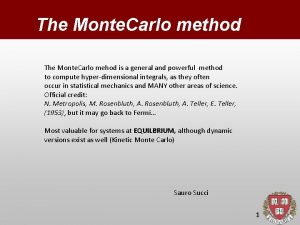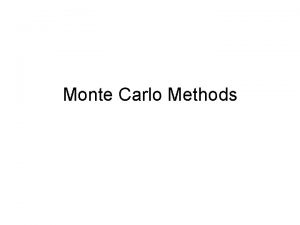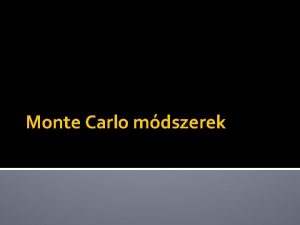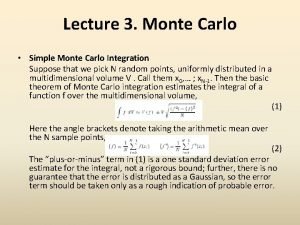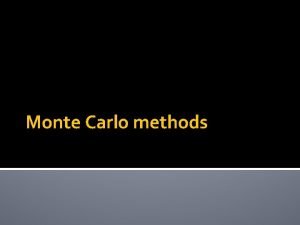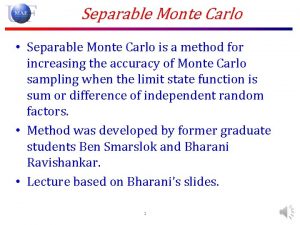Replica Monte Carlo Simulation JianSheng Wang National University




































- Slides: 36

Replica Monte Carlo Simulation Jian-Sheng Wang National University of Singapore 1

Outline • Review of extended ensemble methods (multi-canonical, Wang-Landau, flathistogram, simulated tempering) • Replica MC • Connection to parallel tempering and cluster algorithm of Houdayer • Early and new results 2

Slowing Down at First. Order Phase Transition • At first-order phase transition, the longest time scale is controlled by the interface barrier where β=1/(k. BT), σ is interface free energy, d is dimension, L is linear size 3

Multi-Canonical Ensemble • We define multi-canonical ensemble as such that the (exact) energy histogram is a constant h(E) = n(E) f(E) = const • This implies that the probability of configuration is P(X) f(E(X)) 1/n(E(X)) 4

Multi-Canonical Simulation (Berg et al) • Do simulation with probability weight fn(E), using Metropolis acceptance rate min[1, fn(E’)/fn(E) ] • Collection histogram H(E) • Re-compute weight by fn+1(E) = fn(E)/H(E) • Iterate until H(E) is flat 5

Multi-Canonical Simulation and Reweighting Multicanonical histogram and reweighted canonical distribution for 2 D 10 -state Potts model From A B Berg and T Neuhaus, Phys Rev Lett 68 (1992) 9. 6

Wang-Landau Method • Work directly with n(E), starting with some initial guess, n(E) ≈ const, f = f 0 > 1 (say 2. 7) • Flip a spin according to acceptance rate min[1, n(E)/n(E ’)] • And also update n(E) by n(E) <- n(E) f • Reduce f by f <-f 1/2 after certain number of MC steps, when the histogram H(E) is “flat”. 7

Flat Histogram Algorithm 1. Pick a site at random 2. Flip the spin with probability where E is current and E ’ is new energy 3. Accumulate statistics for <N(σ, E ’-E)>E 8

The Ising Model + + DE=-8 J + + DE=0 + + + - σ = {σ1, σ2, …, σi, … } Total energy is E(σ) = - J ∑<ij> σi σj sum over nearest neighbors, σi = ± 1 N(s, DE) is the number of sites, such that flip spin costs energy DE. 9

Spin Glass Model + - + + + - + - + + - - + - + - + + - - A random interaction Ising model - two types of random, but fixed coupling constants (ferro Jij > 0) and (anti-ferro Jij < 0) 10

Slow Dynamics in Spin Glass Correlation time in single spin flip dynamics for 3 D spin glass. |TT c | 6. From Ogielski, Phys Rev B 32 (1985) 7384. 11

Tunneling Time for 3 D Spin Glass Diamond: standard flat histogram algorithm; dot: with N-fold way; triangle: equalhit algorithm. From J S Wang & R H Swendsen, J Stat Phys, 106 (2002) 245. 12

First-Passage Time to Ground States Number of sweeps needed to discover a ground state for the first time. Extremal Optimization (EO) is an optimization algorithm. From J S Wang and Y Okabe, J Phys Soc Jpn, 72 (2003) 1380. 13

Simulated Tempering (Marinari & Parisi, 1992) • Simulated tempering treats parameters as dynamical variables, e. g. , β jumps among a set of values βi. We enlarge sample space as {X, βi}, and make move {X, βi} -> {X’, β’i} according to the usual Metropolis rate. 14

Replica Monte Carlo • A collection of M systems at different temperatures is simulated in parallel, allowing exchange of information among the systems. β 1 β 2 β 3 . . . βM 15

Moves between Replicas • Consider two neighboring systems, σ1 and σ2, the joint distribution is P(σ1, σ2) exp[-β 1 E(σ1) –β 2 E(σ2)] = exp[-Hpair(σ1, σ2)] • Any valid Monte Carlo move should preserve this distribution 16

Pair Hamiltonian in Replica Monte Carlo • We define i=σi 1σi 2, then Hpair can be rewritten as The Hpair again is a spin glass. If β 1≈β 2, and two systems have consistent signs, the interaction is twice as strong; if they have opposite sign, the interaction 17 is 0.

Cluster Flip in Replica Monte Carlo = +1 = -1 b c Clusters are defined by the values of i of same sign, The effective Hamiltonian for clusters is Hcl = - Σ kbc sbsc Where kbc is the interaction strength between cluster b and c, kbc= sum over boundary of cluster b and c of Kij. Metropolis algorithm is used to flip the clusters, i. e. , σi 1 -> -σi 1, σi 2 -> -σi 2 fixing for all i in a given cluster. 18

Apply Swendsen-Wang in Replica MC = +1 = -1 b c • The -cluster can be further broken down. Within a -cluster, a bond is set with probability P = 1 – exp(-2 (b 1+b 2)|Jij|) if interaction is satisfied Jijsisj > 0; no bond otherwise. • No interaction between clusters broken this way. 19

Implementation Issues • Use Hoshen-Kompelman algorithm to identify clusters • Based on cluster size and total number of clusters, pre-allocate memory to store effective cluster coupling kab • Order O(N) algorithm for each sweep 20

Comparing Correlation Times Single spin flip Correlation times as a function of inverse temperature K=βJ on 2 D, ±J Ising spin glass of 32 x 32 lattice. Replica MC From R H Swendsen and J-S Wang, Phys Rev Lett 57 (1986) 2607. 21

Cluster Algorithm of S Liang 2 D Gaussian spin glass on 16 x 16 lattice, using a generalization due to F Niedermayer. From S Liang, PRL 69 (1992) 2145. 22

Replica Exchange (Hukushima & Nemoto, 1996) • A simple move of exchange configurations, σ1 <-> σ2, with Metropolis acceptance rate min{ 1, exp[(β 2 -β 1)(E(σ2)-E(σ1))] } This is equivalent to flip all the i =-1 clusters in replica Monte Carlo. Also known as parallel tempering 23

Replica Exchange Spin-spin exponential relaxation time for replica exchange on 123 lattice. From K Hukushima and K Nemoto, J Phys Soc Jpn, 65 (1996) 1604. 24

Houdayer’s Cluster Algorithm β 1 β 2 β 3 . . . βM set N . . . Single -cluster flip between same temperature β 1 β 2 β 3 . . . βM set 2 β 1 β 2 β 3 . . . βM set 1 Replica exchange between different temperatures Simulate simultaneously M by N systems. 25

Relaxation towards Equilibrium at Low. T Relaxation of energy for 100 x 100 +/-J Ising spin glass at T = 0. 1 [32 set of 26 replicas for cluster algorithm]. From J Houdayer, Eur Phys J B 22 (2001) 479. 26

Correlation Functions in Replica MC Time correlation function for order parameter q on 128 x 128 ±J Ising spin glass. 106 MCS used. Labels are K=1/T. q=|∑i i| From J-S Wang and R H Swendsen, condmat/0407273. 27

Comparison of Single-spinflip, Parallel Tempering, Houdayer, and Replica MC 2 D ±J Ising spin glass integrated correlation time on a 32 x 32 lattice. From condmat/0407273, to appear (2005) Prog Theor Phys Suppl. 28

Integrated Correlation Times, 128 x 128 system 1/T Replica MC Parallel Tempering Single Spin Flip 5. 0 3. 0 1. 8 1. 6 1. 4 1. 3 1. 0 71 367 13. 5 5. 1 2. 3 2. 4 1. 3 5. 2 x 106 2. 4 x 106 48000 39000 2700 2076 998 163 162. 1 29

Comparison in 3 D Integrated correlation times for ±J Ising spin glass on 12 x 12 lattice. 30

2 D Spin Glass Susceptibility 2 D ±J spin glass susceptibility on 128 x 128 lattice, 1. 8 x 104 MC steps. From J S Wang and R H Swendsen, PRB 38 (1988) 4840. K 5. 11 was concluded. 31

Heat Capacity at Low T c T -2 exp(-2 J/T) slope = -2 This result is confirmed recently by Lukic et al, PRL 92 (2004) 117202. 32

Monte Carlo Renormalization Group YH defined by with RG iterations for difference sizes in 2 D. From J S Wang and R H Swendsen, PRB 37 (1988) 7745. 33

MCRG in 3 D 3 D result of YH. MCS is 104 to 105, with 23 samples for L= 8, 8 samples for L= 12, and 5 samples for L= 16. 34

Correlation Length Correlation length (defined by ratio of wavenumber dependent susceptibilities) on 128 x 128 lattice, averaged of 96 random coupling samples. Unpublished. 35

Summary • Replica MC is very efficient in 2 D, and becomes equivalent to Parallel Tempering in 3 D • Replica MC has been used for equilibrium simulations (heat capacity, MCRG, etc) 36
 Monte carlo simulation minitab 19
Monte carlo simulation minitab 19 Monte carlo simulation advantages and disadvantages ppt
Monte carlo simulation advantages and disadvantages ppt Monte carlo integration matlab
Monte carlo integration matlab Monte carlo simulation freeware
Monte carlo simulation freeware Concezio bozzi
Concezio bozzi Monte carlo alternatives
Monte carlo alternatives Equilikely
Equilikely Monte carlo simulation
Monte carlo simulation Monte carlo simulation dice roll matlab
Monte carlo simulation dice roll matlab Minitab doe
Minitab doe Count of monte carlo
Count of monte carlo Stanislaw ulam
Stanislaw ulam Simulasi monte carlo ppt
Simulasi monte carlo ppt Mnemstudio
Mnemstudio Kinetic monte carlo python
Kinetic monte carlo python Mcts tutorial
Mcts tutorial Eric veach thesis
Eric veach thesis Monte carlo localization for mobile robots
Monte carlo localization for mobile robots Continuous time monte carlo
Continuous time monte carlo Markov chain monte carlo tutorial
Markov chain monte carlo tutorial Monte carlo localization python
Monte carlo localization python Monte carlo radiation transport
Monte carlo radiation transport Metoda monte carlo algorytm
Metoda monte carlo algorytm Monte carlo search tree
Monte carlo search tree Monte carlo search tree
Monte carlo search tree Monte carlo optimization
Monte carlo optimization Metoda monte carlo
Metoda monte carlo Inverse monte carlo
Inverse monte carlo Villa monte carlo
Villa monte carlo Monte carlo data quality
Monte carlo data quality Self-portrait with beret and gold chain
Self-portrait with beret and gold chain Monte carlo truth
Monte carlo truth Monte carlo exercise
Monte carlo exercise Monte carlo exercise
Monte carlo exercise Quantum monte carlo
Quantum monte carlo The monte carlo
The monte carlo Monte carlo sd
Monte carlo sd
